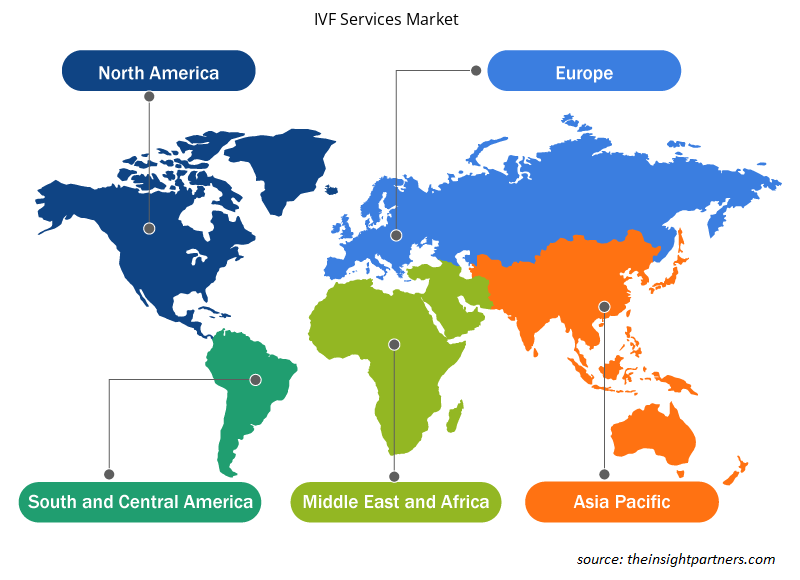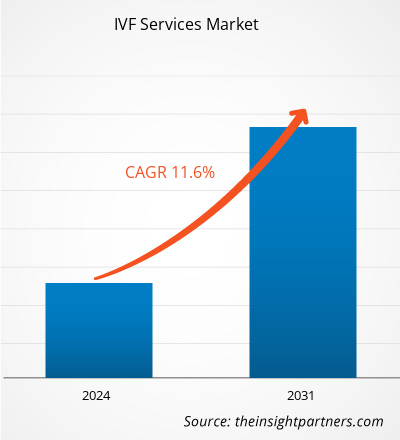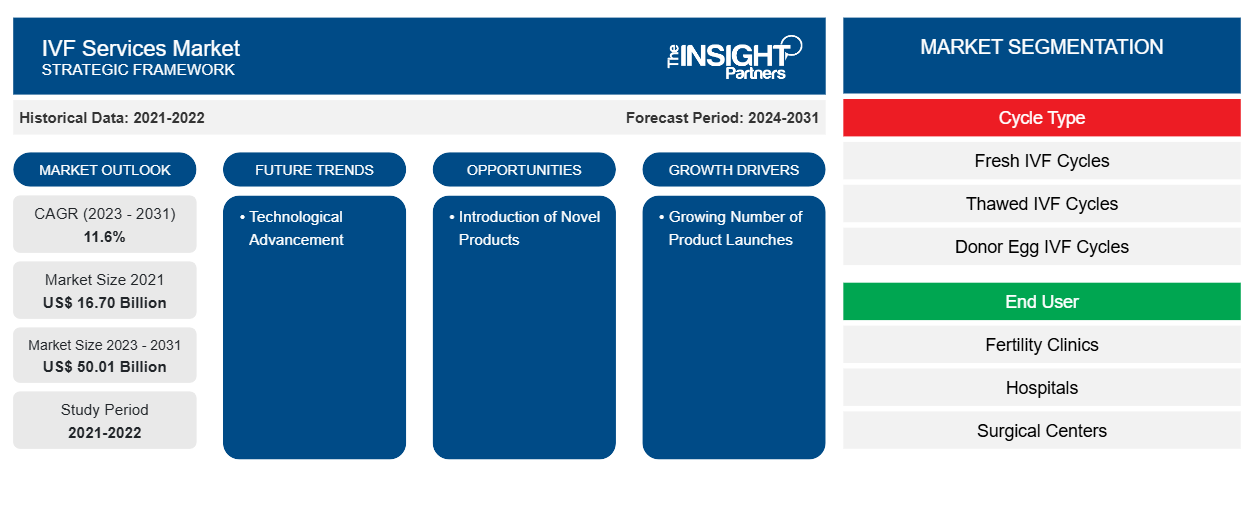El tamaño del mercado de servicios de FIV se estimó en US$ 16,70 mil millones en 2021 y US$ XX millones en 2023 y se espera que alcance los US$ 50,01 mil millones para 2031. Se estima que registrará una CAGR del 11,6% hasta 2031. Es probable que la creciente incidencia de infertilidad, el creciente número de clínicas de fertilidad y servicios de infertilidad con apoyo gubernamental y la integración de la inteligencia artificial en la fertilización in vitro sigan siendo tendencias clave del mercado de servicios de FIV .
Análisis del mercado de servicios de FIV
La FIV, o fertilización in vitro, es una terapia de fertilidad en la que se extraen óvulos de los ovarios de la mujer y se fecundan con esperma fuera del cuerpo. El proceso implica varios pasos y pueden optar por él las parejas o las personas que padecen problemas de fertilidad. En la actualidad, varias clínicas y centros de FIV ofrecen servicios de FIV en todo el mundo.
La tasa de fertilidad está disminuyendo de manera constante a nivel mundial, debido a diversos factores, como la creciente inclinación a los matrimonios tardíos y la creciente infertilidad relacionada con la edad . Se prevé que las tasas de fertilidad mundiales disminuyan a 2,4 hijos por mujer para 2030 y 2,2 hijos por mujer para 2050. Alrededor del 12% de las mujeres en el grupo de edad de 15 a 44 años en los EE. UU. enfrentaron dificultades para quedar embarazadas o lograr un embarazo a término, independientemente del estado civil. Además, alrededor del 6,0% de las mujeres casadas de 15 a 44 años en los EE. UU. son incapaces de quedar embarazadas después de un año de intentarlo (infertilidad). Por lo tanto, la caída de la tasa de fertilidad conduce a un aumento sustancial en la demanda de servicios de fertilización in vitro (FIV) que influyen en la ventana de fertilidad en hombres y mujeres.
Descripción general del mercado de servicios de FIV
La creciente incidencia de la infertilidad, la creciente cifra de clínicas de fertilidad y servicios de infertilidad con apoyo gubernamental y el creciente número de lanzamientos y desarrollos de productos. Sin embargo, el alto costo de los procedimientos de las técnicas reproductivas y los riesgos asociados con el tratamiento de la infertilidad obstaculizan el crecimiento del mercado. El mercado mundial de servicios de FIV está segmentado por región en América del Norte, Europa, Asia Pacífico, Oriente Medio y África, y América del Sur y Central. La región europea tiene la mayor participación de mercado, mientras que la región de Asia Pacífico es la región de más rápido crecimiento. Es probable que factores como el aumento del tratamiento de la infertilidad mediante FIV y TRA, el creciente apoyo del gobierno a través de varios programas, el creciente número de centros de fertilidad en los países y la disminución de la tasa de fertilidad entre las mujeres aumenten el crecimiento del mercado en la región durante los años de pronóstico.
Personalice este informe según sus necesidades
Obtendrá personalización en cualquier informe, sin cargo, incluidas partes de este informe o análisis a nivel de país, paquete de datos de Excel, así como también grandes ofertas y descuentos para empresas emergentes y universidades.
- Obtenga las principales tendencias clave del mercado de este informe.Esta muestra GRATUITA incluirá análisis de datos, desde tendencias del mercado hasta estimaciones y pronósticos.
Impulsores y oportunidades del mercado de servicios de FIV
Creciente número de lanzamientos de productos en desarrollo para favorecer el mercado
Las empresas del mercado de servicios de FIV están aumentando su actividad de investigación y desarrollo para introducir productos más innovadores. Los nuevos ciclos de FIV con descongelación, los ciclos de FIV con óvulos de donante, los sistemas de micromanipuladores y las incubadoras están permitiendo la adopción de tecnologías celulares avanzadas que están fortaleciendo los resultados de los procedimientos. En enero de 2021, Royal Philips, líder mundial en tecnología sanitaria, declaró una asociación plurianual con Merck, una empresa líder en ciencia y tecnología, para desarrollar soluciones digitales de grado clínico para tratamientos de fertilidad altamente personalizados. Se prevé que un número cada vez mayor de lanzamientos de productos, fusiones y adquisiciones y desarrollos impulsen el mercado de servicios de FIV.
Realización de campañas de sensibilización: una oportunidadEl mercado de servicios de FIV
Las campañas de concienciación están contribuyendo sustancialmente a aumentar el alcance de las tecnologías y terapias de FIV entre las poblaciones. Dichas campañas también tienen un potencial considerable para promover nuevos centros de FIV, el intercambio de información y los debates. Por ejemplo, la primera semana de noviembre de 2022 se celebró como la Semana Europea de la Fertilidad 2022. La semana se celebró para invitar a los responsables políticos de toda Europa a mejorar el acceso y la calidad de los tratamientos de infertilidad existentes. Además, organizaciones como Fertility Europe están tomando medidas concretas para difundir la información correcta sobre el tratamiento de la infertilidad. En 2022, la Semana Europea de la Fertilidad dedicará toda la semana a concienciar sobre el proceso de fertilidad de los pacientes y las dificultades a las que a menudo tienen que enfrentarse. Por lo tanto, se espera que la realización de campañas de concienciación adecuadas proporcione plataformas de presentación sólidas para las empresas, ofreciendo así oportunidades de crecimiento para impulsar los ingresos dentro del ecosistema dinámico.
Análisis de segmentación del informe de mercado de servicios de FIV
Los segmentos clave que contribuyeron a la derivación del análisis del mercado de servicios de FIV son el tipo de ciclo y el usuario final.
- Según el tipo de ciclo, el mercado de servicios de FIV se divide en ciclos de FIV, ciclos de FIV con óvulos descongelados y ciclos de FIV con óvulos de donante. El segmento de ciclos de FIV en fresco tuvo la mayor participación del mercado en 2023; además, se prevé que el mismo segmento registre el porcentaje de CAGR más alto del mercado durante el período de pronóstico.
- Por usuarios finales, el mercado está segmentado en hospitales, clínicas de fertilidad, centros quirúrgicos e institutos de investigación clínica. El segmento de centros de fertilidad tuvo la mayor participación del mercado en 2023; además, se espera que el segmento registre la CAGR más alta del mercado durante 2023-2031.
Análisis de la cuota de mercado de los servicios de FIV por geografía
El alcance geográfico del informe de mercado de servicios de FIV se divide principalmente en cinco regiones: América del Norte, Asia Pacífico, Europa, Oriente Medio y África, y América del Sur/América del Sur y Central. América del Norte ha dominado el mercado de servicios de FIV después de Europa. Hay un aumento en la tasa de tratamiento de la infertilidad en todo el país. Según el Informe de tasas de éxito de las clínicas de fertilidad de 2018 de los CDC, se realizaron 306.197* ciclos de TRA en 456 clínicas informantes en los Estados Unidos durante 2018, lo que resultó en 73.831 nacimientos vivos (partos de uno o más bebés vivos) y 81.478 bebés nacidos vivos. América del Norte tuvo la mayor participación en 2023. Una inclinación hacia productos técnicamente avanzados y la presencia de actores del mercado global son factores que contribuyen al dominio del mercado de servicios de FIV de América del Norte. Se prevé que Asia Pacífico crezca con la CAGR más alta en los próximos años.
Perspectivas regionales del mercado de servicios de FIV
Los analistas de Insight Partners explicaron en detalle las tendencias y los factores regionales que influyen en el mercado de servicios de FIV durante el período de pronóstico. Esta sección también analiza los segmentos y la geografía del mercado de servicios de FIV en América del Norte, Europa, Asia Pacífico, Oriente Medio y África, y América del Sur y Central.

- Obtenga datos regionales específicos para el mercado de servicios de FIV
Alcance del informe sobre el mercado de servicios de FIV
| Atributo del informe | Detalles |
|---|---|
| Tamaño del mercado en 2021 | US$ 16.70 mil millones |
| Tamaño del mercado en 2031 | US$ 50.01 mil millones |
| CAGR global (2023 - 2031) | 11,6% |
| Datos históricos | 2021-2022 |
| Período de pronóstico | 2024-2031 |
| Segmentos cubiertos | Por tipo de ciclo
|
| Regiones y países cubiertos | América del norte
|
| Líderes del mercado y perfiles de empresas clave |
|
Densidad de actores del mercado: comprensión de su impacto en la dinámica empresarial
El mercado de servicios de FIV está creciendo rápidamente, impulsado por la creciente demanda de los usuarios finales debido a factores como la evolución de las preferencias de los consumidores, los avances tecnológicos y una mayor conciencia de los beneficios del producto. A medida que aumenta la demanda, las empresas amplían sus ofertas, innovan para satisfacer las necesidades de los consumidores y aprovechan las tendencias emergentes, lo que impulsa aún más el crecimiento del mercado.
La densidad de actores del mercado se refiere a la distribución de las empresas o firmas que operan dentro de un mercado o industria en particular. Indica cuántos competidores (actores del mercado) están presentes en un espacio de mercado determinado en relación con su tamaño o valor total de mercado.
Las principales empresas que operan en el mercado de servicios de FIV son:
- Atención sanitaria máxima,
- FIV Bloom,
- CCRM Fertilidad,
- FERTILIDAD DE OXFORD,
- Crear Salud (Crear Fertilidad),
- Medicover,
Descargo de responsabilidad : Las empresas enumeradas anteriormente no están clasificadas en ningún orden particular.

- Obtenga una descripción general de los actores clave del mercado de servicios de FIV
Noticias y desarrollos recientes del mercado de servicios de FIV
El mercado de servicios de FIV se evalúa mediante la recopilación de datos cualitativos y cuantitativos posteriores a la investigación primaria y secundaria, que incluye publicaciones corporativas importantes, datos de asociaciones y bases de datos. A continuación, se incluye una lista de los avances en el mercado de servicios de FIV y las estrategias:
- En abril de 2023, Cryoport, Inc., un proveedor líder mundial de soluciones innovadoras de cadena de suministro con control de temperatura para la industria de las ciencias biológicas y líder en soluciones de cadena de suministro para los mercados de medicina reproductiva, anunció un acuerdo plurianual con Inception Fertility. Inception Fertility opera The Prelude Network® (Prelude), la red de centros de fertilidad basada en tecnología más grande y de más rápido crecimiento en América del Norte. (Fuente: Prelude Fertility, comunicado de prensa, 2024)
- En abril de 2023, The Prelude Network, un proveedor líder de servicios integrales de fertilidad en América del Norte, anunció una asociación exclusiva con Future Family (FF), una plataforma nacional para la formación de familias con planes financieros flexibles y servicios de apoyo de conserjería. La asociación tiene como objetivo ampliar la accesibilidad financiera a servicios de fertilidad de primera calidad, empoderando a los pacientes con más opciones financieras y una comprensión clara de los costos del tratamiento. Fuente: (Prelude Fertility, comunicado de prensa, 2024)
Informe sobre el mercado de servicios de FIV: cobertura y resultados
El informe “Tamaño y pronóstico del mercado de servicios de FIV (2021-2031)” proporciona un análisis detallado del mercado que cubre las siguientes áreas:
- Tamaño del mercado y pronóstico a nivel global, regional y nacional para todos los segmentos clave del mercado cubiertos bajo el alcance
- Dinámica del mercado, como impulsores, restricciones y oportunidades clave
- Principales tendencias futuras
- Análisis detallado de las cinco fuerzas de Porter y PEST y FODA
- Análisis del mercado global y regional que cubre las tendencias clave del mercado, los principales actores, las regulaciones y los desarrollos recientes del mercado.
- Análisis del panorama de la industria y de la competencia que abarca la concentración del mercado, el análisis de mapas de calor, los actores destacados y los desarrollos recientes
- Perfiles detallados de empresas
- Análisis histórico (2 años), año base, pronóstico (7 años) con CAGR
- Análisis PEST y FODA
- Tamaño del mercado, valor/volumen: global, regional y nacional
- Industria y panorama competitivo
- Conjunto de datos de Excel
Informes recientes
Testimonios
Razón para comprar
- Toma de decisiones informada
- Comprensión de la dinámica del mercado
- Análisis competitivo
- Información sobre clientes
- Pronósticos del mercado
- Mitigación de riesgos
- Planificación estratégica
- Justificación de la inversión
- Identificación de mercados emergentes
- Mejora de las estrategias de marketing
- Impulso de la eficiencia operativa
- Alineación con las tendencias regulatorias





















 Obtenga una muestra gratuita para - Mercado de servicios de FIV
Obtenga una muestra gratuita para - Mercado de servicios de FIV